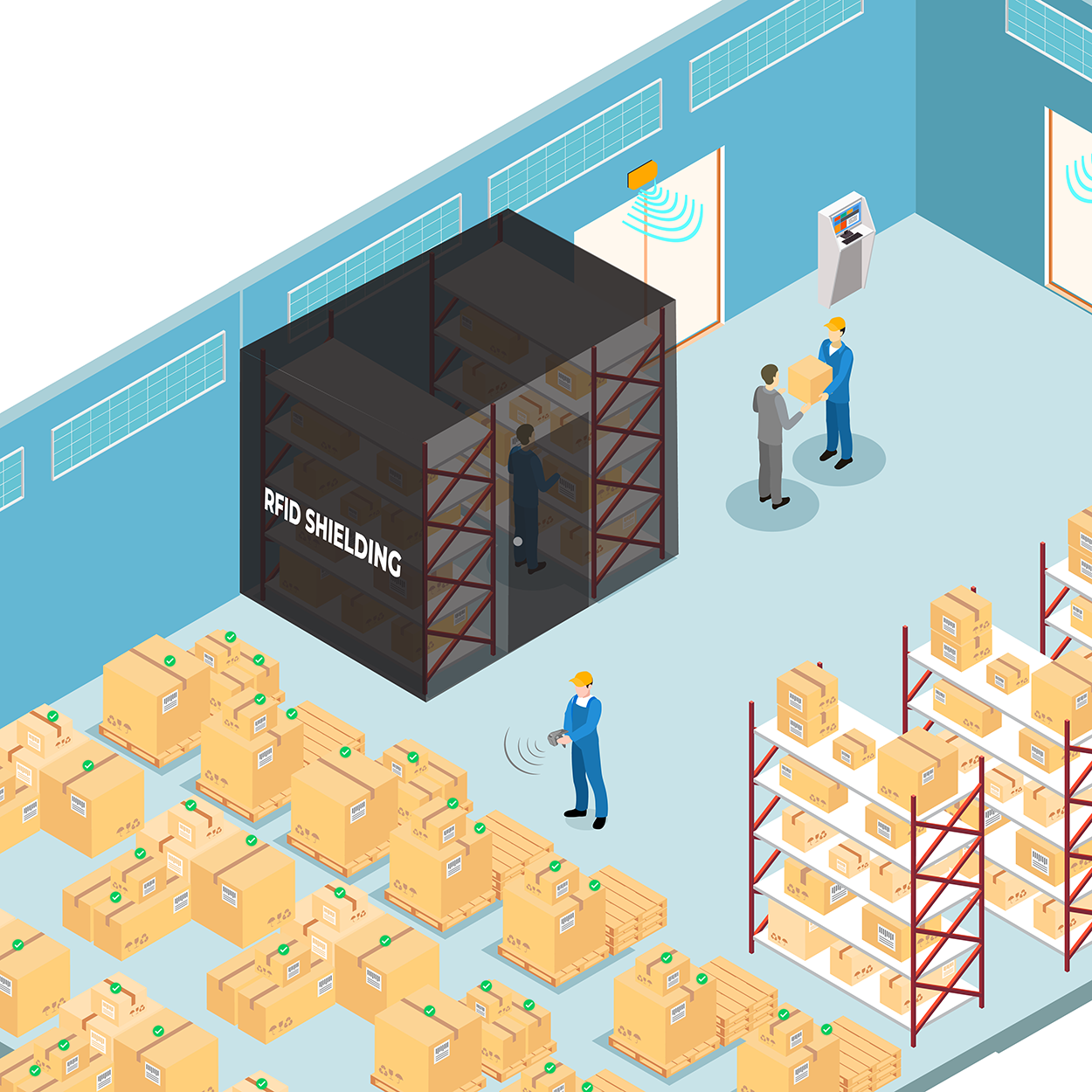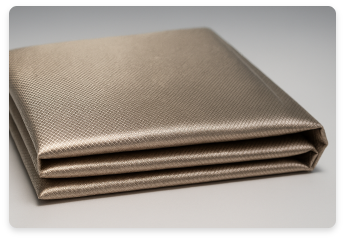RFID Shielding
HOW RFID IT ASSET TRACKING WORKS?
Radio Frequency Identification (RFID) technology offers convenience and efficiency, but also comes with risks. Without proper shielding, your RFID-enabled assets, data, and inventory are vulnerable to Unwanted Tracking Data Theft, Unauthorized Access, Signal Interference, Unwanted Read Zones
RFID shielding protects your business and assets from malicious scans and ensures data integrity by blocking or attenuating RFID signals as needed.

Absorption
Materizals absorb and dissipate electromagnetic energy.

Reflection
High-conductivity materials reflect signals away.

Redirection
Signals are diffused or redirected to prevent them from reaching the tag.
INDUSTRIES WE SERVE IN RF SHIELDING
INDUSTRIES WE SERVE IN RF SHIELDING

Retail & supply chain
Prevent cross-reads and unauthorized inventory checks in distribution centers and stores.

Healthcare
Shield patient data and ensure equipment integrity in rfid-enabled hospital environments.

Defense & Aerospace
RFID tags secure mission-critical assets, documents, and prevent surveillance via rfid-based systems.

Financial Institutions
Financial institutions, such as banks and investment firms, use rfid-enabled systems to track assets like sensitive documents or equipment.

Access Control
Access control systems in workplaces, labs, data centers, and government buildings often rely on rfid cards or fobs to regulate entry.

Allow Only Authorized Access.
Prevent skimming attacks and unauthorized access to secure areas and devices.

Corporate and R&D
Protect intellectual property and control access to rfid-tagged assets in sensitive environments.
Frequently Asked Questions (FAQs)
-
What is RFID shielding?
RFID shielding refers to the use of materials or devices that block or reduce the transmission of radio frequency signals to prevent unauthorized RFID tag scanning. Shielding is used to enhance security and privacy by protecting RFID tags from being read by unauthorized readers.
-
Why is RFID shielding important?
RFID shielding is important to:
- • Avoid unauthorized tracking of individuals or assets
- • Ensure compliance with data protection regulations
- • Improve inventory control by eliminating unintended reads in high-density environments
-
How does RFID shielding work?
RFID shielding materials (such as metalized fabrics or aluminum) act as barriers to radio waves, either by absorbing or reflecting them. This interrupts the electromagnetic field needed to power and communicate with RFID tags, thus preventing data exchange between the tag and reader.
-
How long does RFID deployment take?
RFID deployment timelines depend on the scale and complexity of the project. A pilot can take a few weeks, while full-scale enterprise rollouts may take several months, including site surveys, testing, integration, and training.
-
What materials are commonly used for RFID shielding?
Common RFID shielding materials include:
- • Aluminum foil or sheets, Copper foil, Metal mesh or fabrics, Carbon-based shielding films, Faraday cage enclosures
- • These materials are often incorporated into wallets, bags, rooms, and storage units.
-
What is a Faraday cage, and how is it used for RFID shielding?
Faraday cage is an enclosure made of conductive material that blocks external static and non-static electric fields. In RFID applications, it’s used to completely shield tags from radio waves. Faraday cages are used in labs, secure facilities, or storage areas to prevent RFID tag activation.
-
Can RFID shielding block all types of RFID tags?
RFID shielding is effective across most frequency bands, but the efficiency depends on the shielding material and tag frequency:
- • Low Frequency (LF - 125/134 kHz): Harder to shield due to magnetic coupling
- • High Frequency (HF - 13.56 MHz): Easier to block with common shielding materials
- • Ultra High Frequency (UHF - 860–960 MHz): Easiest to shield due to wave-based communication
-
Where is RFID shielding most commonly used?
RFID shielding is used in:
- • RFID-blocking wallets and passport holders
- • Retail and warehouse storage shelves
- • Secure government and corporate facilities
- • Laboratories and test chambers
- • RFID tag programming areas (to avoid cross reads)
-
Are there RFID shielded storage solutions for businesses?
Yes. Businesses often use:
- Shielded storage cabinets and lockers, RFID-blocking bins or boxes, Shielded cages for high-security zones.
- These are especially useful in asset tracking, inventory control, and sensitive data protection.
-
Can RFID shielding interfere with the intended RFID system operation?
Yes. Improper or unintentional RFID shielding can:
- • Prevent tag reads, causing false negatives
- • Disrupt automated processes
- • Limit read range
- • It’s crucial to strategically implement shielding to block unwanted reads without interfering with legitimate operations.
-
How can I test if my RFID shielding is working
You can test RFID shielding by:
- • Placing an RFID-enabled item (e.g., access card) inside the shielding material (e.g., RFID-blocking wallet).
- • Attempting to scan it with a reader or terminal.
- • If no response is received, the shielding is effective.
- • For high-stakes environments, use RF test equipment or professional RF audits to validate performance.






